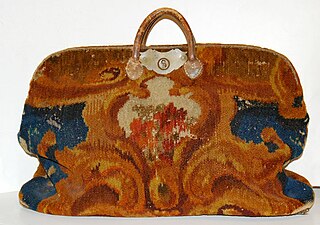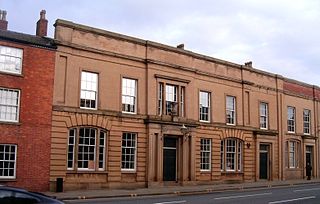Related Research Articles

The history of rail transport began in the prehistoric times. It can be divided into several discrete periods defined by the principal means of track material and motive power used.

A stagecoach is a four-wheeled public transport coach used to carry paying passengers and light packages on journeys long enough to need a change of horses. It is strongly sprung and generally drawn by four horses.
A suitcase is a form of luggage. It is often a somewhat flat, rectangular-shaped bag with rounded square corners. Vinyl, leather or cloth suitcases may have a metal frame. Hardshell suitcases open on hinges like a door.

A pannier is a basket, bag, box, or similar container, carried in pairs either slung over the back of a beast of burden, or attached to the sides of a bicycle or motorcycle. The term derives from a Middle English borrowing of the Old French panier, meaning 'bread basket'.

Louis Vuitton Malletier, commonly known as Louis Vuitton or by its initials LV, is a French fashion house and luxury goods company founded in 1854 by Louis Vuitton. The label's LV monogram appears on most of its products, ranging from luxury trunks and leather goods to ready-to-wear, shoes, watches, jewelry, accessories, sunglasses and books. Louis Vuitton is one of the world's leading international fashion houses. It sells its products through standalone boutiques, lease departments in high-end departmental stores, and through the e-commerce section of its website.

A trunk, also known as a travel trunk, is a large cuboid container designed to hold clothes and other personal belongings. They are most commonly used for extended periods away from home, such as for boarding school, or long trips abroad. Trunks are differentiated from chests by their more rugged construction due to their intended use as luggage, instead of the latter's pure storage.

Baggage or luggage consists of bags, cases, and containers which hold a traveller's personal articles while the traveler is in transit. A modern traveller can be expected to have packages containing clothing, toiletries, small possessions, trip necessities. On the return trip, travelers may have souvenirs and gifts. For some people, luggage and the style thereof is representative of the owner's wealth and status. Luggage is constructed to protect the items during travel, either with a hard shell or a durable soft material. Luggage often has internal subdivisions or sections to aid in securing items. Handles are typically provided to facilitate carrying, and some luggage may have wheels and/or telescoping handles or leashes to make moving them easier.

Various methods of transporting children have been used in different cultures and times. These methods include baby carriages, infant car seats, portable bassinets (carrycots), strollers (pushchairs), slings, backpacks, baskets and bicycle carriers.

Wicker is a technique for making products woven from any one of a variety of pliable plant materials, a generic name for the materials used in such manufacture, and a term for the items so produced. The word wicker is believed to be of Scandinavian origin: vika, which means to bend in Swedish, and vikker meaning willow. Wicker is traditionally made of material of plant origin, such as willow, rattan, reed, and bamboo, but synthetic fibers are now also used. Wicker is light yet sturdy, making it suitable for items that will be moved often like porch and patio furniture. Rushwork and wickerwork are terms used in England. A typical braiding pattern is called Wiener Geflecht, Viennese Braiding, as it was invented in 18th century Vienna and later most prominently used with the Thonet coffeehouse chair.

A carpet bag is a top-opening travelling bag made of carpet, commonly from an oriental rug. It was a popular form of luggage in the United States and Europe in the 19th century, featuring simple handles and only an upper frame, which served as its closure. Some small modern versions are used as handbags or purses.

Basket weaving is the process of weaving or sewing pliable materials into three-dimensional artifacts, such as baskets, mats, mesh bags or even furniture. Craftspeople and artists specialized in making baskets may be known as basket makers and basket weavers. Basket weaving is also a rural craft.

Transport in Sheffield, England is developed around the city's unusual topography and medieval street plan. Once an isolated town, the transport infrastructure changed dramatically in the 19th and 20th centuries. The city now has road and rail links with the rest of the country, and road, bus and trams for local transport.

Goyard is a French trunk and leather goods maker. Established in 1853 in Paris, and previously doing business as Martin and then Morel, it is older than Louis Vuitton by one year, although Bally was founded even earlier in 1851. François Goyard (1828–1890) made box making, packing and trunk making the family's trade when he purchased Maison Morel, successor to Maison Martin. Edmond Goyard (1860–1937) expanded his business from 1885 to 1937. Robert Goyard (1893–1979) was the face of the brand during the booming post-war years. François Goyard played a significant role in further increasing the firm's growth with his daughter Isabelle Goyard (1959-). Jean-Michel Signoles bought Goyard in 1998, and turned the privately owned company into an internationally renowned brand.
The Bay Express was a passenger train between Wellington and Napier in New Zealand's North Island, operating from Monday, 11 December 1989 until Sunday, 7 October 2001. It was operated by New Zealand Railways Corporation's InterCity Rail division, later known as Tranz Scenic.

Liverpool Road is a former railway station on the Liverpool and Manchester Railway in Manchester, England that opened on 15 September 1830. The station was the Manchester terminus of the world's first inter-city passenger railway in which all services were hauled by timetabled steam locomotives. It is the world's oldest surviving terminal railway station.
Moynat is a French luxury fashion company. Their first atelier was opened in Paris in 1849 by trunk-makers Octavie and François Coulembier. They joined forces with Pauline Moynat, a specialist in travel goods, to open the first store of avenue de l’Opera. Moynat was one of the first leather goods houses of its day. Known for its traditional know-how and skills base in handcrafting made-to-order luggage and travel goods, the house became famous for its designs for the automobiles, as well as for its technical innovations such as making its trunks lighter and waterproof, and for its notable participation in the various World's Fairs.
H.J. Cave & Sons is a London-based leather luxury goods company founded in 1839 by Harriet Jane Cave and the inventor of several products including the luxury leather handbag, expanding luggage, women's luggage and railway baskets.

Belber is a heritage American leather goods company founded in Philadelphia in 1891.

Au Départ is a Parisian trunkmaker founded in Paris in 1834.
The house of Finnigans was a British luxury luggage and trunk maker established in 1830, originally in Manchester and later in New Bond Street in London. The house of Finnigans was once one of the finest British leather goods makers and a successful luxury goods retailer. Renowned for its traditional know-how and craftsmanship, Finnigans manufactured and produced a wide range of luxury products, including trunks, bags, fashion, jewelry, timepieces, and silverware.
References
- ↑ "Public Opinion Volume 11". Public Opinion. p. 220.
- ↑ H.J. Cave & Sons, Manufacturers of Railway Dress Baskets, Portmanteaus, Travelling Bags, English & Foreign Wicker & Cane Basket Work: Inventors and Patentees of the "Royal Victoria" Quinquepartite Expanding Basket.
- ↑ "Victoria Magazine Volume 8". 1866. p. 369.